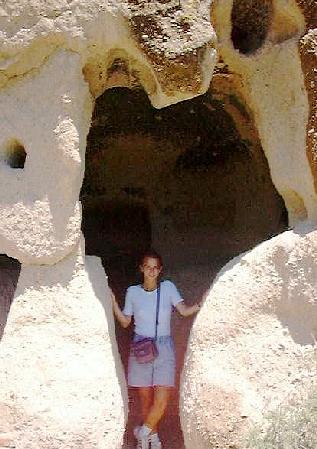
Puye Cliff Dwellings

View from the Pajarito Plateau
Saturday 7th August 1999
The Puye Cliff Dwellings are part of the Santa Clara Indian Pueblo, near the little town of Espanola, about 30 miles north of Santa Fe. Built in to the side of a cliff, the site was ocupied from about 1250 until 1577 by over 1500 Pueblo Indians. They formed part of the Anasazi culture, which is now usually referred to as the Ancestral Pueblan culture. The word Anasazi is the Navajo term meaning "the ancient ones". According to the Santa Clara Indians' traditions, their ancestors lived in the area of Puye until a drought caused the springs to dry up and the crops to fail. The name Puye itself means "pueblo ruin where the rabbits assemble or meet".

Veronika in a cavate room at Puye
The ruins themselves display several types of rooms. The most obvious type is the so-called cavate form. The rock of the cliff is soft rock, called volcanic tuff. This consists of layers of compressed volcanic ash, and is very soft and therefore easily eroded. The inhabitants of the area used this to their advantage, carving rooms out of the rockface using stone or even wood tools. The roofs of the cavate rooms show distinctive carving marks to indicate that they were man-made, although some of them would make very convincing natural caves. Each unit consists of a number of inter-connected rooms - presumably if a family had another child they could simply carve out another room! Originally, the rooms would have had level floors made of smoothed adobe clay. Adobe is mud and straw mixed together and then baked in the sun to form a solid and readily shapeable building material. Indeed, much of Santa Fe (or at least the facades of the buildings) is built of adobe.

The view from inside a cavate room at Puye
Living in one of the cavate rooms would not have been too pleasant - the ceilings are blackened, indicating that the uppper part of the rooms must have been regularly filled with smoke. To alleviate the problems this caused, floor vents were built into the rooms to allow fresh air into them, and vents in the ceiling helped the smoke to escape, but it couldn't have been too effective. Also, the tuff bedrock has cracks and fissures throughout, so that rain and melting snow would filter from the mesa above into the rooms below. When this water froze, it would place pressure on the rocks, leading to collapses. This was another hazard the people living here had to face.

Talus room
The second type of structure at Puye is called talus. These consisted of multi-storey structures built of adobe bricks in front of the cavate rooms. These would often involve substantial earthworks simply to level the ground in front of the cliff to allow them to be built in the first instance. In order to build multiple storeys, the people would drill post holes into the cliff face, into which large timbers were inserted. These formed the basis of ceilings/floors; a second, cross layer of smaller timbers was placed on top to finish the floor. These timbers would then be built into the adobe wall, creating a building of remarkable stability. This structure can be seen in the picture above. High on the cliff face are a number of petroglyphs (rock inscriptions); the most common are concentric circles, spirals and stylised animal and human figures. They reminded me strongly of the "ring and cup marks" and other stone markings scattered around Scotland.

Veronika on a stairway of light inside a kiva on the mesa top
At the top of the cliff is a large mesa (Spanish for table, it is a flat piece of land high above the surrounding area with steep cliffs on most/all sides). This was the location of the communitry house, a large collection of rooms with an enclosed plaza which may have served a defensive or ceremonial purpose. When the site was excavated, reports suggested that this structure was two or three storeys high. The best preserved section is the kiva, an underground circular structure used for ceremonial purposes across the south-western US. Its underground location acted as insulation against both heat and noise: we found it a pleasant refuge from the extreme heat of the high desert. The structure also seemed to amplify noise greatly, and this may have been deliberate to heighten the effect of ritual drumming.
Next | Travel index | Family history | Romany | Main index